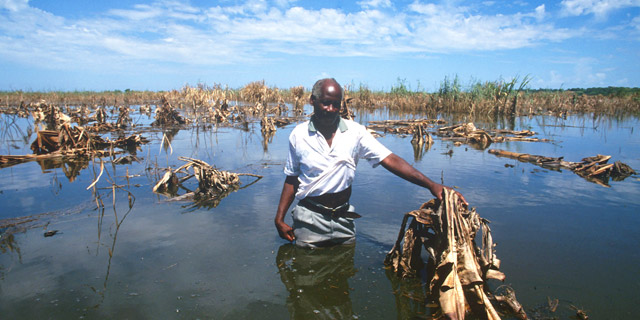Description

Disclaimer: Copyright infringement not intended
Context
- Agriculture crops cultivated in about 50.40 lakh hectare of area have been affected across the country due to heavy rains, floods and landslides so far this year, with maximum damage reported in Karnataka, Parliament was informed on Tuesday.
Some Statistics: FAO findings
- Nearly a quarter of damages caused by natural disasters in the developing world are borne by the agriculture sector, according to Food and Agricultural Organization (FAO).
- More than 22 per cent of the damages caused by natural hazards—such as drought, floods, storms or tsunamis—are accounted for by the agriculture sector.
- The 22 per cent figure represents only damages reported via post-disaster risk assessments, so while indicative of scale, the actual impact is likely to be even higher, says FAO.
- During drought period, agriculture absorbs up to 84 percent of all economic impacts.
- Within the agricultural sector, 42 per cent of assessed losses were to crops ($13 billion) - with floods being the main culprit, responsible for 60 per cent of crop damages, followed by storms (23 per cent of crop damages).
- These damages and losses are often incurred by poor rural and semi-rural communities without insurance and lacking the financial resources needed to regain lost livelihoods.
Need to secure the sector
- Agriculture and all that it encompasses is not only critical for our food supply, it also remains a main source of livelihoods across the planet.
- While it is a sector at risk, agriculture also can be the foundation upon which we build societies that are more resilient and better equipped to deal with disasters,
Climate-resilient agriculture
- Climate-resilient agriculture (CRA) is an approach that includes sustainbly using existing natural resources through crop and livestock production systems to achieve long-term higher productivity and farm incomes under climate variabilities.
- This practice reduces hunger and poverty in the face of climate change for forthcoming generations.
- CRA practices can alter the current situation and sustain agricultural production from the local to the global level, especially in a sustainable manner.
- Improved access and utilisation of technology, transparent trade regimes, increased use of resources conservation technologies, an increased adaptation of crops and livestock to climatic stress are the outcomes from climate-resilient practices.
- Most countries have been facing crises due to disasters and conflicts; food security, however, is adversely affected by inadequate food stocks, basic food price fluctuations, high demand for agro-fuels, and abrupt weather changes.
Strategies and technologies for climate change adaptation
Tolerant crops
- Patterns of drought may need various sets of adaptive forms.
- Example: To reach deficient downpour conditions, early maturing and drought-tolerant cultivars of green gram (BM 2002-1), chickpea and pigeon pea (BDN-708) were brought on selected farmer’s fields in Aurangabad district of Maharashtra (rainfall of 645 millimetres).
- This provided 20-25 per cent higher yield than the indigenous cultivars.
Water management
- Water-smart technologies like a furrow-irrigated raised bed, micro-irrigation, rainwater harvesting structure, cover-crop method, greenhouse, laser land levelling, reuse wastewater, deficit irrigation and drainage management can support farmers to decrease the effect of variations of climate.
- Various technologies based on a precision estimation of crop water needs; groundwater recharge techniques; adoption of scientific water conservation methods; altering the fertilizer and irrigation schedules; cultivating less water requiring varieties; adjusting the planting dates; irrigation scheduling; and adopting zero-tillage which may help farmers to reach satisfactory crop yields, even in deficit rainfall and warmer years.
Agro-advisory
- Response farming is an integrative approach; it could be called farming with advisories taken from the technocrats depending on local weather information.
- The success of response farming, viz., decreased danger and enhanced productivity has already been taken in Tamil Nadu and many other states.
- Response farming can be a viable choice for climate change adoption strategies, for the variations of climate is not a sudden one.
- The main cause for the success of response farming is because of both location and time-specific technologies.
- It is time to take forward the success of response farming to the entire farming community.
Soil organic carbon
- Different farm management practices can increase soil carbon stocks and stimulate soil functional stability.
- Conservation agriculture technologies (reduced tillage, crop rotations, and cover crops), soil conservation practices (contour farming) and nutrient recharge strategies can refill soil organic matter by giving a protective soil cover.
- Integrated nutrient management deals with the application of organic and inorganic fertilizers, in addition to farmyard manure, vermicompost, legumes in rotation, and crop residue for sustaining soil health for the long term.
- Feeding the soil instead of adding fertilizers to the crop without organic inputs is the key point for the long-term sustainability of Indian agriculture.
National Programmes for climate change adaptation
- The National Mission of Sustainable Agriculture was implemented in 2010 under the National Action Plan on Climate Change (NAPCC) to promote the judicious management of available resources and this was one of the eight missions under NAPCC.
- The Pradhan Mantri Krishi Sinchayee Yojana (PMKSY) was launched in 2015 to address the issues of water resources and provide a permanent solution that envisages Per Drop More Crop, by promoting micro / drip irrigation for the conservation of maximum water.
- The Paramparagat Krishi Vikas Yojana mission was executed to extensively leverage adaptation of climate-smart practices and technologies in conjunction with the Indian Council of Agricultural Research and state governments of India.
- To mitigate climate extreme actions, Green India Mission was launched by the GOI in 2014 under the umbrella of NAPCC with the primary objective of protecting, restoring and enhancing India’s diminishing forest covers, thereby reducing the deleterious effects of climate change.
- To protect the soil health, GOI has launched the Soil Health Card scheme with the main objective of analysing cluster soil samples and advocating farmers regarding their land fertility status. Additionally, Neem-Coated Urea was also introduced to minimise the excess addition of urea fertilizers, thereby protecting soil health and supplying plant nitrogen.
- To encourage farmers with more income benefit and ecosystem protection, programmes such as the National Project on Organic Farming and National Agroforestry Policy was introduced in 2004 and 2014 respectively.
- These policies are aimed at supplying plant nutrients in the form of organic amendments, soil carbon stock improvement, and soil protection from erosion loss.
Role Models
- Andhra Pradesh, Himachal Pradesh, Sikkim, etc, have already initiated several programmes to adopt and promote organic farming practices on a wider scale. Sikkim is an organic state.
- The ICAR, through its network research Institutes, state agriculture universities and all line departments is implementing agriculture contingency plans in about 650 districts of India towards climate change preparedness for the last seven years.
- These models are taken forward to SAARC countries towards adaptation to climate change impacts like floods, cyclones, droughts, and heat waves and seawater intrusion.
- ICAR has established climate-resilient villages across India in 151 districts, which are replicated by the state governments towards the overall objective of building carbon positive villages.
Way ahead
In a nutshell, following steps are crucial to build climate resilient agriculture systems and achieve sustainable development goals (SDG) in India:
- Adaptation of appropriate mitigation technologies such as the cultivation of tolerant breeds to overcome the climate stress
- Water and nutrient management for efficient productivity and resource utilisation
- Agro-advisories for timely crop monitoring
- Conservation agricultural practices to build soil organic carbon and to build congenial environment for plant growth, manure management
- Reduction of greenhouse gas emissions from all agriculture and non-agricultural sources has to be prioritised. The introduction of neem-coated urea is one such policy intervention
- Structured training is essential to build confidence in stakeholders and sensitise them to understand the climate change events
- Fine tuning the gap between current management practices and essential agro-advisories
- Implementing CRA across the country is the need of the hour
- Flagship farmer-oriented programmes are needed to improvise skills in agriculture and allied sectors
- Collaboration between farmers, research institutions, funding agencies, governments, and non-government organisations and private sectors combine strengths to promote CRA
https://economictimes.indiatimes.com/news/economy/agriculture/agri-crops-in-50-40-lakh-hectare-hit-due-to-heavy-rains-floods-so-far-this-year-narendra-singh-tomar/articleshow/88010167.cms








